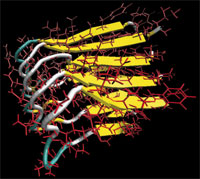Showing Spotlights 513 - 520 of 629 in category All (newest first):
 Nature is truly a brilliant nano engineer and has been so for billions of years. There is an abundance of 'smart' biological materials with hierarchical nanostructures - built from proteins - that are capable of adapting to new tasks, are self-healing, and can self-assemble autonomously simply out of a solution of building blocks. The performance and capability of these natural materials is something engineers can only dream of today. But by unlocking nature's secrets tiny step by tiny step, one day we will be able to not only duplicate but surpass the performance of natural materials. Only in recent years have scientists begun to understand the underlying principles and mechanisms of these materials - Why is spider silk stronger than steel? Why can cells be stretched reversibly several times of their original length? What kinds of molecular flaws lead to malfunctions in cells and tissues, as it occurs in Alzheimer's, rapid ageing disease progeria or muscle dystrophies, diseases in which the cell or tissue fails mechanically? Scientists at MIT have, for the first time, revealed the fundamental fracture and deformation mechanisms of biological protein materials, clarifying some long-standing issues about the deformation behavior of cells and Alzheimer's pathogens. The researchers report that the fracture mechanisms of two abundant nanoscopic building blocks of many proteins and protein materials exhibit two distinct fracture modes, depending on the speed of deformation. This is a surprising observation with far-reaching implications for the development of novel self-assembled protein materials and possibly the cure of certain genetic diseases
Nature is truly a brilliant nano engineer and has been so for billions of years. There is an abundance of 'smart' biological materials with hierarchical nanostructures - built from proteins - that are capable of adapting to new tasks, are self-healing, and can self-assemble autonomously simply out of a solution of building blocks. The performance and capability of these natural materials is something engineers can only dream of today. But by unlocking nature's secrets tiny step by tiny step, one day we will be able to not only duplicate but surpass the performance of natural materials. Only in recent years have scientists begun to understand the underlying principles and mechanisms of these materials - Why is spider silk stronger than steel? Why can cells be stretched reversibly several times of their original length? What kinds of molecular flaws lead to malfunctions in cells and tissues, as it occurs in Alzheimer's, rapid ageing disease progeria or muscle dystrophies, diseases in which the cell or tissue fails mechanically? Scientists at MIT have, for the first time, revealed the fundamental fracture and deformation mechanisms of biological protein materials, clarifying some long-standing issues about the deformation behavior of cells and Alzheimer's pathogens. The researchers report that the fracture mechanisms of two abundant nanoscopic building blocks of many proteins and protein materials exhibit two distinct fracture modes, depending on the speed of deformation. This is a surprising observation with far-reaching implications for the development of novel self-assembled protein materials and possibly the cure of certain genetic diseases
Oct 10th, 2007
 Nanoimprint lithography (NIL) has developed into a key technique for the fabrication of polymer nanopatterns and three-dimensional (3D) nanostructures. At its core, NIL is a simple nanometer scale pattern transfer process where a master mold with a desired pattern is used to fabricate identical patterns in an imprint resist, typically a polymer, with subsequent heat or light curing of the resulting mold. The attractivity of NIL comes from its capability for patterning with high resolution, high fidelity, high throughput, and low cost. Using NIL, nanometer sized patterns can easily be formed on various substrates, including silicon wafers, glass plates, flexible polymer films, and even nonplanar substrates. The limitation of conventional NIL techniques lies in their resulting patterned 2D layers; the formation of 3D micro- and nanostructures by stacking the 2D layers cannot be achieved by conventional NIL. That's why researchers came up with reverse nanoimprint lithography, a technique to transfer patterned 2D layers and to form multistacked 3D micro- and nanostructures on the substrate. While this works in principal, the achievable yields are very low due to the difficulty of detaching the master mold from the 3D structure. Researchers in South Korea have now managed to demonstrate the first successful fabrication of multi-stacked 2D nano patterned slabs on various substrates including flexible polymer film. This means real 3D nano structures such as photonic crystals can be fabricated with reasonable cost.
Nanoimprint lithography (NIL) has developed into a key technique for the fabrication of polymer nanopatterns and three-dimensional (3D) nanostructures. At its core, NIL is a simple nanometer scale pattern transfer process where a master mold with a desired pattern is used to fabricate identical patterns in an imprint resist, typically a polymer, with subsequent heat or light curing of the resulting mold. The attractivity of NIL comes from its capability for patterning with high resolution, high fidelity, high throughput, and low cost. Using NIL, nanometer sized patterns can easily be formed on various substrates, including silicon wafers, glass plates, flexible polymer films, and even nonplanar substrates. The limitation of conventional NIL techniques lies in their resulting patterned 2D layers; the formation of 3D micro- and nanostructures by stacking the 2D layers cannot be achieved by conventional NIL. That's why researchers came up with reverse nanoimprint lithography, a technique to transfer patterned 2D layers and to form multistacked 3D micro- and nanostructures on the substrate. While this works in principal, the achievable yields are very low due to the difficulty of detaching the master mold from the 3D structure. Researchers in South Korea have now managed to demonstrate the first successful fabrication of multi-stacked 2D nano patterned slabs on various substrates including flexible polymer film. This means real 3D nano structures such as photonic crystals can be fabricated with reasonable cost.
Oct 8th, 2007
 Individual nanoscale building blocks, such as nanoparticles, nanosheets, nanowires or nanotubes display unique and unusually impressive mechanical properties. These mechanical properties of nanomaterials cannot be extrapolated from their bulk properties and scientists are still busily exploring the nanoscale behavior of various materials. Once the nanoscale properties of a material are known, the next problem is how to practically exploit certain properties and transfer them back into a macro structure of a bulk material. Materials engineers would love to transfer the exceptional mechanical properties such as tensile strength and Young's modulus (a measure of stiffness that reflects the resistance of a material to elongation) of nanoscale materials into nanocomposites that then cold be used to build much tougher, lighter and flexible materials than anything we know today - say a paper thin sheet of nanocomposite material that is transparent, flexible, yet as strong as steel. So far, effective load transfer and homogenous dispersion appear to be the key issues in order to take advantage of the extraordinary properties of nanomaterials for mechanical reinforcement applications. New research coming out of the University of Michigan has resulted in nanocomposite materials with a very high content of inorganic component and nearly perfect stress transfer. The stiffness and tensile strength of these multilayer composites are an order of magnitude greater than those of analogous nanocomposites at a processing temperature that is much lower than those of ceramic or polymer materials with similar characteristics.
Individual nanoscale building blocks, such as nanoparticles, nanosheets, nanowires or nanotubes display unique and unusually impressive mechanical properties. These mechanical properties of nanomaterials cannot be extrapolated from their bulk properties and scientists are still busily exploring the nanoscale behavior of various materials. Once the nanoscale properties of a material are known, the next problem is how to practically exploit certain properties and transfer them back into a macro structure of a bulk material. Materials engineers would love to transfer the exceptional mechanical properties such as tensile strength and Young's modulus (a measure of stiffness that reflects the resistance of a material to elongation) of nanoscale materials into nanocomposites that then cold be used to build much tougher, lighter and flexible materials than anything we know today - say a paper thin sheet of nanocomposite material that is transparent, flexible, yet as strong as steel. So far, effective load transfer and homogenous dispersion appear to be the key issues in order to take advantage of the extraordinary properties of nanomaterials for mechanical reinforcement applications. New research coming out of the University of Michigan has resulted in nanocomposite materials with a very high content of inorganic component and nearly perfect stress transfer. The stiffness and tensile strength of these multilayer composites are an order of magnitude greater than those of analogous nanocomposites at a processing temperature that is much lower than those of ceramic or polymer materials with similar characteristics.
Oct 5th, 2007
 Modern nanotechnology researchers not only borrow extensively from nature to develop new materials and fabrication techniques, they also manage to transfer proven, and sometimes ancient, technologies into their nanotechnology laboratories. We've written about this before in our stories about welding ("Bronze Age technique works just fine in the nanotechnology era") and metal forging ("From Bronze Age shack to nanotechnology lab - metal forging techniques reach the bottom"). Today, our story deals with yet another ur-technology: spinning. Spinning is the process of creating yarn (or thread, rope, cable) from various raw fiber materials. The first spinning wheel was invented in India probably some 2,500-3,000 years ago, although some claim that the Chinese used similar devices as long as almost 5,000 years ago to spin silk threads. While spinning is one of the core technology foundations of our civilization, researchers have now begun to apply cotton-spinning techniques to fabricate carbon nanotube (CNT) "yarn."
Modern nanotechnology researchers not only borrow extensively from nature to develop new materials and fabrication techniques, they also manage to transfer proven, and sometimes ancient, technologies into their nanotechnology laboratories. We've written about this before in our stories about welding ("Bronze Age technique works just fine in the nanotechnology era") and metal forging ("From Bronze Age shack to nanotechnology lab - metal forging techniques reach the bottom"). Today, our story deals with yet another ur-technology: spinning. Spinning is the process of creating yarn (or thread, rope, cable) from various raw fiber materials. The first spinning wheel was invented in India probably some 2,500-3,000 years ago, although some claim that the Chinese used similar devices as long as almost 5,000 years ago to spin silk threads. While spinning is one of the core technology foundations of our civilization, researchers have now begun to apply cotton-spinning techniques to fabricate carbon nanotube (CNT) "yarn."
Oct 4th, 2007
 Shuttles - whether the space shuttle, an airport shuttle bus, or a loom shuttle - basically do one thing: they transport cargo (astronauts, passengers, thread) from one point to another on a controlled route. Although not always called shuttles, the basic concept is critical to modern transportation systems and is used by nearly every society. The concept of the shuttle has been used for centuries from Egyptian barges to Roman railways and canals. Even before these inventions, however, nature employed molecular shuttles in biological organisms. In molecular shuttles, kinesin proteins propel cargo (such as organelles) along hollow tubes called microtubules. Cells use these motors to transport cargo to highly specific destinations, in order to regulate levels of macromolecules and processes, much like a train along a track. Using biological motors to transport and precisely distribute cargo requires a clear understanding of how molecular shuttles pick up and deliver specific payload. However, scientists are challenged by the need to better control the interactions along the route so that the cargo remains on the line when not needed, but when it is needed, can be picked up and transported to a specific location. Researchers in Switzerland have now built nanoscale cargo loading stations and shuttles, an important step towards assembly lines for nanotechnology.
Shuttles - whether the space shuttle, an airport shuttle bus, or a loom shuttle - basically do one thing: they transport cargo (astronauts, passengers, thread) from one point to another on a controlled route. Although not always called shuttles, the basic concept is critical to modern transportation systems and is used by nearly every society. The concept of the shuttle has been used for centuries from Egyptian barges to Roman railways and canals. Even before these inventions, however, nature employed molecular shuttles in biological organisms. In molecular shuttles, kinesin proteins propel cargo (such as organelles) along hollow tubes called microtubules. Cells use these motors to transport cargo to highly specific destinations, in order to regulate levels of macromolecules and processes, much like a train along a track. Using biological motors to transport and precisely distribute cargo requires a clear understanding of how molecular shuttles pick up and deliver specific payload. However, scientists are challenged by the need to better control the interactions along the route so that the cargo remains on the line when not needed, but when it is needed, can be picked up and transported to a specific location. Researchers in Switzerland have now built nanoscale cargo loading stations and shuttles, an important step towards assembly lines for nanotechnology.
Oct 3rd, 2007
 Bridges are exciting to cross, incredible works of engineering and they have made it possible for us to travel more easily, quickly and safely. The U.S. Congress even approved $400 million to build a bridge to nowhere. While bridges have been, and still are, essential components in every society's infrastructure, the bridge concept is becoming interesting to nanotechnology researchers as well. Nanomaterial air bridges enable nanoscale structures to be suspended as a two-point beam, creating a nanomechanical element that is isolated from a variety of substrate effects, including adhesion, temperature, conductivity, and parasitic capacitance. The bridge-like suspension makes nanoscale structures accessible along their length, which is beneficial for examining ehmt but also for device construction. It also allows nearfield probing, manipulation, and actuation of these suspended nanostructures. Scientists at the University of Louisville have found a way to build nanomaterial air bridges simply and conveniently.
Bridges are exciting to cross, incredible works of engineering and they have made it possible for us to travel more easily, quickly and safely. The U.S. Congress even approved $400 million to build a bridge to nowhere. While bridges have been, and still are, essential components in every society's infrastructure, the bridge concept is becoming interesting to nanotechnology researchers as well. Nanomaterial air bridges enable nanoscale structures to be suspended as a two-point beam, creating a nanomechanical element that is isolated from a variety of substrate effects, including adhesion, temperature, conductivity, and parasitic capacitance. The bridge-like suspension makes nanoscale structures accessible along their length, which is beneficial for examining ehmt but also for device construction. It also allows nearfield probing, manipulation, and actuation of these suspended nanostructures. Scientists at the University of Louisville have found a way to build nanomaterial air bridges simply and conveniently.
Sep 26th, 2007
 Back in the early 1800's it was observed that certain chemicals can speed up a chemical reaction - a process that became known as catalysis and that has become the foundation of the modern chemical industry. By some estimates 90% of all commercially produced chemical products involve catalysts at some stage in the process of their manufacture. Catalysis is the acceleration of a chemical reaction by means of a substance, called a catalyst, which is itself not consumed by the overall reaction. The most effective catalysts are usually transition metals or transition metal complexes. An everyday example of catalysis is the catalytic converter in your car which is used to reduce the toxicity of emissions from your car's engine. Here the catalysts are platinum and manganese which for instance convert harmful nitrogen oxides into harmless nitrogen and oxygen. Since catalysts provide a surface for the chemical reaction to take place on, nanoparticles with their extremely large surface area have become much researched as catalysts (as particles get smaller the larger their surface to volume ratio becomes). Especially in heterogeneous catalysis - where the catalyst is in a different phase (ie. solid, liquid and gas) to the reactants, and that is largely influenced by surface properties - use of nanoscale catalysts opens up a number of possibilities of improving catalytic activity and selectivity. Unfortunately, heterogeneous catalysts supported on a carrier prepared using traditional methods (e.g., impregnation) suffer from a number of problems, such as particle aggregation during preparation, sintering during use (especially at high temperatures), and catalyst leaching because of solvent or pressure drop. This is associated with the poor contact of the catalyst particle with the support surface. A new method of catalyst preparation coming out of Singapore may offer a new concept for catalyst optimization.
Back in the early 1800's it was observed that certain chemicals can speed up a chemical reaction - a process that became known as catalysis and that has become the foundation of the modern chemical industry. By some estimates 90% of all commercially produced chemical products involve catalysts at some stage in the process of their manufacture. Catalysis is the acceleration of a chemical reaction by means of a substance, called a catalyst, which is itself not consumed by the overall reaction. The most effective catalysts are usually transition metals or transition metal complexes. An everyday example of catalysis is the catalytic converter in your car which is used to reduce the toxicity of emissions from your car's engine. Here the catalysts are platinum and manganese which for instance convert harmful nitrogen oxides into harmless nitrogen and oxygen. Since catalysts provide a surface for the chemical reaction to take place on, nanoparticles with their extremely large surface area have become much researched as catalysts (as particles get smaller the larger their surface to volume ratio becomes). Especially in heterogeneous catalysis - where the catalyst is in a different phase (ie. solid, liquid and gas) to the reactants, and that is largely influenced by surface properties - use of nanoscale catalysts opens up a number of possibilities of improving catalytic activity and selectivity. Unfortunately, heterogeneous catalysts supported on a carrier prepared using traditional methods (e.g., impregnation) suffer from a number of problems, such as particle aggregation during preparation, sintering during use (especially at high temperatures), and catalyst leaching because of solvent or pressure drop. This is associated with the poor contact of the catalyst particle with the support surface. A new method of catalyst preparation coming out of Singapore may offer a new concept for catalyst optimization.
Sep 24th, 2007
 Just kidding - I always wanted to write a tabloid headline like that! In case you are expecting a story on the mysteries of crop circles caused by alien nanotechnology - stop reading right here; but the analogy is just too striking when you look at the amazing images coming out of the labs at the University of Southern California, where they developed a new technique to create three-dimensional carbon nanotube structures. While carbon nanotubes possess many exceptional properties which far exceed most known bulk materials, creating controlled nanotube (CNT) microstructures has always been a challenge. Overcoming this challenge is going to be key in developing useful and commercially viable CNT devices. Existing techniques for patterning three-dimensional CNT structures are based on the bottom-up growth of multiwalled CNTs (MWCNTs) from a patterned catalyst, which is limited to 2D-like geometries. Other, complex 3D microstructures have been fabricated with polymer-based resin materials but not with CNTs. The new technique developed by researchers in California uses a focused laser beam to selectively burn local regions of a dense forest of MWCNTs. This technique enables chemically sensitive fields to take advantage of nanotubes' exceptional properties and expand their possible applications into new areas.
Just kidding - I always wanted to write a tabloid headline like that! In case you are expecting a story on the mysteries of crop circles caused by alien nanotechnology - stop reading right here; but the analogy is just too striking when you look at the amazing images coming out of the labs at the University of Southern California, where they developed a new technique to create three-dimensional carbon nanotube structures. While carbon nanotubes possess many exceptional properties which far exceed most known bulk materials, creating controlled nanotube (CNT) microstructures has always been a challenge. Overcoming this challenge is going to be key in developing useful and commercially viable CNT devices. Existing techniques for patterning three-dimensional CNT structures are based on the bottom-up growth of multiwalled CNTs (MWCNTs) from a patterned catalyst, which is limited to 2D-like geometries. Other, complex 3D microstructures have been fabricated with polymer-based resin materials but not with CNTs. The new technique developed by researchers in California uses a focused laser beam to selectively burn local regions of a dense forest of MWCNTs. This technique enables chemically sensitive fields to take advantage of nanotubes' exceptional properties and expand their possible applications into new areas.
Sep 21st, 2007
 Nature is truly a brilliant nano engineer and has been so for billions of years. There is an abundance of 'smart' biological materials with hierarchical nanostructures - built from proteins - that are capable of adapting to new tasks, are self-healing, and can self-assemble autonomously simply out of a solution of building blocks. The performance and capability of these natural materials is something engineers can only dream of today. But by unlocking nature's secrets tiny step by tiny step, one day we will be able to not only duplicate but surpass the performance of natural materials. Only in recent years have scientists begun to understand the underlying principles and mechanisms of these materials - Why is spider silk stronger than steel? Why can cells be stretched reversibly several times of their original length? What kinds of molecular flaws lead to malfunctions in cells and tissues, as it occurs in Alzheimer's, rapid ageing disease progeria or muscle dystrophies, diseases in which the cell or tissue fails mechanically? Scientists at MIT have, for the first time, revealed the fundamental fracture and deformation mechanisms of biological protein materials, clarifying some long-standing issues about the deformation behavior of cells and Alzheimer's pathogens. The researchers report that the fracture mechanisms of two abundant nanoscopic building blocks of many proteins and protein materials exhibit two distinct fracture modes, depending on the speed of deformation. This is a surprising observation with far-reaching implications for the development of novel self-assembled protein materials and possibly the cure of certain genetic diseases
Nature is truly a brilliant nano engineer and has been so for billions of years. There is an abundance of 'smart' biological materials with hierarchical nanostructures - built from proteins - that are capable of adapting to new tasks, are self-healing, and can self-assemble autonomously simply out of a solution of building blocks. The performance and capability of these natural materials is something engineers can only dream of today. But by unlocking nature's secrets tiny step by tiny step, one day we will be able to not only duplicate but surpass the performance of natural materials. Only in recent years have scientists begun to understand the underlying principles and mechanisms of these materials - Why is spider silk stronger than steel? Why can cells be stretched reversibly several times of their original length? What kinds of molecular flaws lead to malfunctions in cells and tissues, as it occurs in Alzheimer's, rapid ageing disease progeria or muscle dystrophies, diseases in which the cell or tissue fails mechanically? Scientists at MIT have, for the first time, revealed the fundamental fracture and deformation mechanisms of biological protein materials, clarifying some long-standing issues about the deformation behavior of cells and Alzheimer's pathogens. The researchers report that the fracture mechanisms of two abundant nanoscopic building blocks of many proteins and protein materials exhibit two distinct fracture modes, depending on the speed of deformation. This is a surprising observation with far-reaching implications for the development of novel self-assembled protein materials and possibly the cure of certain genetic diseases
 Subscribe to our Nanotechnology Spotlight feed
Subscribe to our Nanotechnology Spotlight feed





